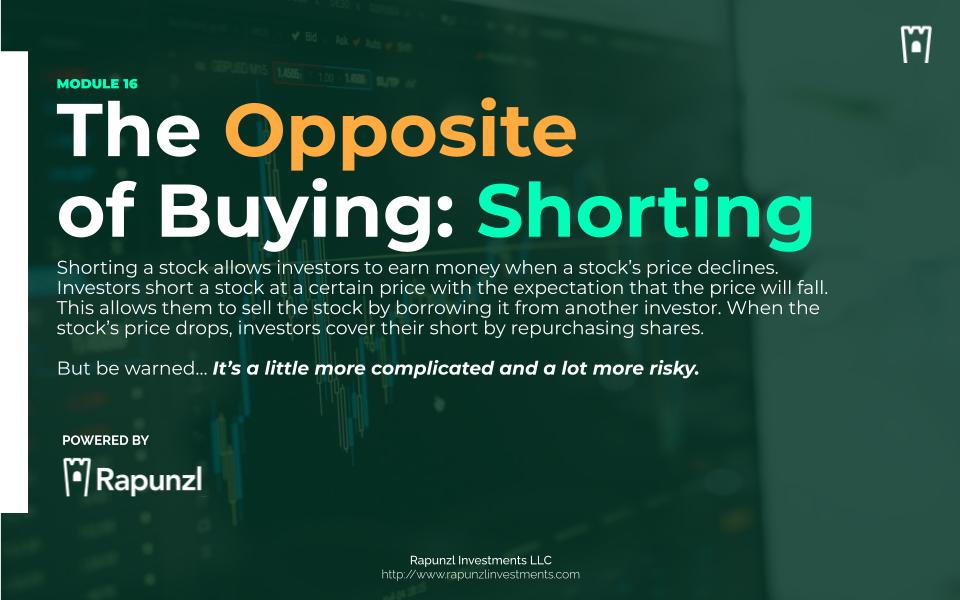
Module 16
Understanding Shorting A Stock
In this module, we explore how shorting a stock allows investors to earn money when a stock’s price declines. Investors short a stock at a certain price with the expectation that the price will fall. This allows them to sell the stock by borrowing it from another investor.
We cover the basics and also explore the infinite risk, highlighting why shorting is not a safe investing practice for most investors.
Module At A Glance
Grade Levels:
6th - 12th
Est. Length:
1-3 Hours (14 slides)
Activities:
1 Activites
Articles:
5 Articles
Languages:
English & Spanish
Curriculum Fit:
Math, Business, Economics, CTE, Social Studies
Standards Alignment:
CEE National Standards, Jump$tart National Standards & Relevant State Standards

Guiding Questions
- How do investors choose what to invest in and what happens if the investor believes a stock price will decline?
- What does it mean to short a stock and how can investors leverage shorting as a tool?
- How do investors make money from shorting?
- What are the risks associated with shorting?
- Why is shorting a stock more risky than just owning a stock and hoping the price increases?
Enduring Understandings
- Shorting can be thought of as the opposite of investing, because an investor will earn a profit if the price per share decreases instead of increasing.
- Shorting occurs on margin, which means investors who short a stock use debt to do so, because they must first borrow the stock.
- For inexperienced investors, shorting can lead to significant losses.
- When shorting a stock, your risk is unlimited because a stock’s price can increase infinitely.
Module Vocab & Key Topics
Shorting A Stock
Shorting a stock involves borrowing shares to sell them with the expectation that the price will drop, allowing repurchase at a lower rate to earn a profit.
Covering A Short
The act of repurchasing the borrowed shares to return them to the lender, ideally at a lower price, is known as covering a short.
Margin Account
This is a specialized brokerage account used for shorting stocks that provides assurance to the brokerage firm that any losses from shorting will be covered.
Dividend
A payment made by a corporation to its shareholders. In the context of shorting, the short-seller is liable to pay dividends on the borrowed shares, not receive them.
Ex-Dividend Date
The date by which an investor must own a stock to receive its next dividend. For a short seller, not closing their position by this date makes them liable to pay the dividend.
Margin Call
A demand from a broker to deposit more money or securities into a margin account to cover potential losses.
Short Squeeze
A situation where a lack of supply and an excess demand for a stock forces its price upwards, trapping short-sellers who may then need to cover their positions at a loss.
Unlimited Losses
A potential risk in shorting stocks, as there's no limit to how much a stock price can increase, leading to potentially unlimited financial liability for the short seller.
Margin Interest
The interest that accrues in a margin account for the period a short position is open, and it is deducted from any gains made from the short.
Stockbrokers
Professionals or firms authorized to buy and sell stocks. In the context of shorting, stockbrokers lend shares to investors.
Financial Ineptitude
Signs or indicators that a company is financially unstable or poorly managed, often considered a potential reason to short its stock.
Risk Management
The practice of identifying potential risks in advance and taking steps to mitigate them. Critical for short-selling due to its inherently risky nature.










